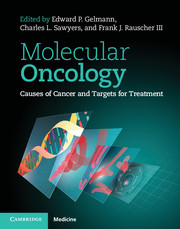Book contents
- Frontmatter
- Dedication
- Contents
- List of Contributors
- Preface
- Part 1.1 Analytical techniques: analysis of DNA
- Part 1.2 Analytical techniques: analysis of RNA
- Part 2.1 Molecular pathways underlying carcinogenesis: signal transduction
- Part 2.2 Molecular pathways underlying carcinogenesis: apoptosis
- Part 2.3 Molecular pathways underlying carcinogenesis: nuclear receptors
- Part 2.4 Molecular pathways underlying carcinogenesis: DNA repair
- Part 2.5 Molecular pathways underlying carcinogenesis: cell cycle
- Part 2.6 Molecular pathways underlying carcinogenesis: other pathways
- Part 3.1 Molecular pathology: carcinomas
- Part 3.2 Molecular pathology: cancers of the nervous system
- Part 3.3 Molecular pathology: cancers of the skin
- Part 3.4 Molecular pathology: endocrine cancers
- Part 3.5 Molecular pathology: adult sarcomas
- Part 3.6 Molecular pathology: lymphoma and leukemia
- Part 3.7 Molecular pathology: pediatric solid tumors
- Part 4 Pharmacologic targeting of oncogenic pathways
- 78 Oncology drug discovery for biologics: antibody development strategies and considerations
- 79 Targeting the EGFR family of receptor tyrosine kinases
- 80 Therapeutic approaches with antibodies to cell-surface receptors
- 81 Signal transduction in tumor angiogenesis
- 82 Tyrosine-kinase inhibitors in oncology
- 83 Anti-estrogens and selective estrogen-receptor modulators
- 84 Therapeutic applications of anti-sense mechanisms for the treatment of cancer
- 85 Induction of apoptosis
- 86 DNA-methylation inhibitors
- 87 Histone deacetylase inhibitors
- 88 Drug resistance: as complex and diverse as the disease itself
- 89 Molecular profiling and therapeutic decision-making: the promise of personalized medicine
- 90 DNA repair inhibition in anti-cancer therapeutics
- Index
- References
84 - Therapeutic applications of anti-sense mechanisms for the treatment of cancer
from Part 4 - Pharmacologic targeting of oncogenic pathways
Published online by Cambridge University Press: 05 February 2015
- Frontmatter
- Dedication
- Contents
- List of Contributors
- Preface
- Part 1.1 Analytical techniques: analysis of DNA
- Part 1.2 Analytical techniques: analysis of RNA
- Part 2.1 Molecular pathways underlying carcinogenesis: signal transduction
- Part 2.2 Molecular pathways underlying carcinogenesis: apoptosis
- Part 2.3 Molecular pathways underlying carcinogenesis: nuclear receptors
- Part 2.4 Molecular pathways underlying carcinogenesis: DNA repair
- Part 2.5 Molecular pathways underlying carcinogenesis: cell cycle
- Part 2.6 Molecular pathways underlying carcinogenesis: other pathways
- Part 3.1 Molecular pathology: carcinomas
- Part 3.2 Molecular pathology: cancers of the nervous system
- Part 3.3 Molecular pathology: cancers of the skin
- Part 3.4 Molecular pathology: endocrine cancers
- Part 3.5 Molecular pathology: adult sarcomas
- Part 3.6 Molecular pathology: lymphoma and leukemia
- Part 3.7 Molecular pathology: pediatric solid tumors
- Part 4 Pharmacologic targeting of oncogenic pathways
- 78 Oncology drug discovery for biologics: antibody development strategies and considerations
- 79 Targeting the EGFR family of receptor tyrosine kinases
- 80 Therapeutic approaches with antibodies to cell-surface receptors
- 81 Signal transduction in tumor angiogenesis
- 82 Tyrosine-kinase inhibitors in oncology
- 83 Anti-estrogens and selective estrogen-receptor modulators
- 84 Therapeutic applications of anti-sense mechanisms for the treatment of cancer
- 85 Induction of apoptosis
- 86 DNA-methylation inhibitors
- 87 Histone deacetylase inhibitors
- 88 Drug resistance: as complex and diverse as the disease itself
- 89 Molecular profiling and therapeutic decision-making: the promise of personalized medicine
- 90 DNA repair inhibition in anti-cancer therapeutics
- Index
- References
Summary
Introduction
Our understanding of the molecular pathways controlling tumor growth, survival, and metastasis has increased at a staggering pace over the last decades. Large-scale institutional efforts such as The Cancer Genome Atlas projects have identified previously unknown mutations with high frequencies in various cancers (1). These data, when combined with pathway analysis tools, point us towards genetic events most likely to be important “drivers” of cancer and to those that may be simply “passenger” mutations (2,3). In addition, the widespread availability of functional genomic tools, such as siRNA, shRNA vectors, and genetically engineered mouse models (GEM models), and anti-sense technology, has allowed individual laboratories to carefully evaluate the role of selected genes and pathways, defining their contributions to various aspects of tumorigenesis. Importantly, from these efforts, novel ideas about the fundamentals of the cancer process itself have recently emerged. These include the supporting role of non-tumor cells in the tumor micro-environment, the concept of cancer stem cells, epithelial-to-mesenchymal transitions, the various mechanisms that tumors employ to ensure immune evasion, the principle of oncogene addiction, and the increasingly interesting contribution of non-coding RNAs, to name only a few (4–7). These insights have given us hope that the recent migration of cancer treatment away from untargeted cytotoxic therapy to selective molecular-targeted therapies will ultimately be translated into novel life-saving cancer treatments.
- Type
- Chapter
- Information
- Molecular OncologyCauses of Cancer and Targets for Treatment, pp. 893 - 902Publisher: Cambridge University PressPrint publication year: 2013

